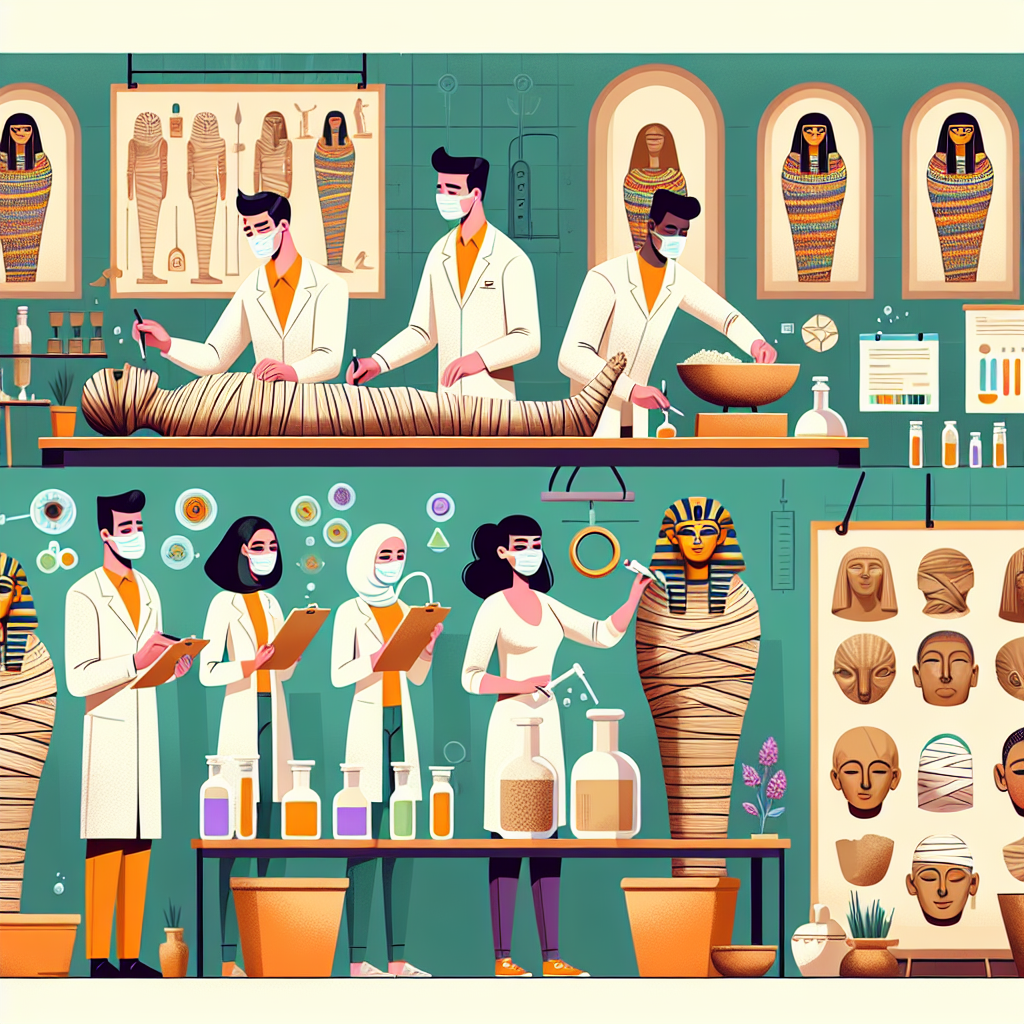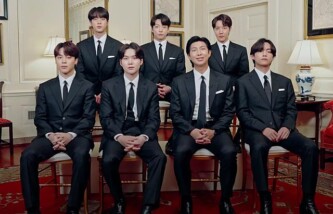Scientists studied old Egyptian mummies. They found out that mummies smell “woody,” “spicy,” and “sweet.” They used special machines and people with good noses to smell the mummies. The smell comes from things like pine and cedar used in mummification. These smells have lasted for over 5,000 years.
The study helps us learn how ancient Egyptians made mummies. It shows what materials they used. This can help museums show the smells to visitors. People can learn more about Egyptian history this way. The scientists want to make museum visits more fun with these smells.
Original news source: Ancient Egyptian mummies smell ‘sweet’ and ‘spicy’, researchers say (Sky News)
🎧 Listen:
Slow
Normal
Fast
📖 Vocabulary:
| 1 | scientists | People who study and learn about things |
| 2 | mummies | Old bodies wrapped up from a long time ago |
| 3 | smell | What you sense with your nose |
| 4 | machines | Things that help people do work, like robots |
| 5 | noses | The part of your face you use to smell |
| 6 | pine | A type of tree with needles |
| 7 | cedar | A type of tree with a nice scent |
| 8 | mummification | The process of making a mummy |
| 9 | materials | Things used to make or build something |
| 10 | visitors | People who come to see a place or event |
Group or Classroom Activities
Warm-up Activities:
– CHARADES
Instructions: Students will act out words related to the article without speaking, such as “mummy,” “Egypt,” “smell,” and “ancient.” The rest of the class will guess what the word is based on their actions.
– VOCABULARY PICTIONARY
Instructions: Divide the class into small groups. Each group will select a word from the article (like “woody,” “spicy,” or “museum”) and draw it on the board. The other groups will guess the word based on the drawing.
– OPINION POLL
Instructions: Ask students how they feel about mummies and ancient Egypt. They can express their opinions by raising their hands to agree or disagree with statements like “I think mummies are interesting” or “I want to visit a museum.”
– THINK-PAIR-SHARE
Instructions: Have students think individually about what they would like to learn about ancient Egypt. Then, they will pair up to share their thoughts with a partner before sharing with the class.
– HEADLINE CREATION
Instructions: Students will work in pairs to create a catchy headline for the article. They can use simple phrases like “Discovering Ancient Smells” or “Secrets of the Mummies” and then share their headlines with the class.
🤔 Comprehension Questions:
1. Who studied the old Egyptian mummies?
2. What do the mummies smell like?
3. What special tools did the scientists use to smell the mummies?
4. What things made the mummies smell good?
5. How long have the smells lasted?
6. Why is the study important for museums?
7. How can the smells help people learn about Egyptian history?
Go to answers ⇩
🎧✍️ Listen and Fill in the Gaps:
Scientists studied old (1)______ mummies. They found out that mummies smell “woody,” “spicy,” and “sweet.” They used (2)______ machines and people with good noses to (3)______ the mummies. The smell comes from things like pine and cedar (4)______ in mummification. These smells have lasted for over 5,000 (5)______.
The study helps us learn how ancient Egyptians made mummies. It (6)______s what materials they used. This can help museums show the (7)______ to visitors. People can learn more about Egyptian (8)______ this way. The scientists want to make museum visits more fun with these smells.
Go to answers ⇩
💬 Discussion Questions:
Students can ask a partner these questions, or discuss them as a group.
1. What is a mummy?
2. Do you like to smell new things? Why or why not?
3. How would you feel if you could smell a mummy?
4. Do you think old things can smell special? Why?
5. What is your favorite smell?
6. How do you think people made mummies a long time ago?
7. Do you like visiting museums? Why or why not?
8. What is a fun smell you would like to have in a museum?
9. How would you feel if you could learn about history by smelling?
10. Do you think scientists are cool? Why?
11. What is a smell that makes you happy?
12. How would you feel if you found an old mummy?
Individual Activities
📖💭 Vocabulary Meanings:
Match each word to its meaning.
Words:
1. scientists
2. mummies
3. smell
4. machines
5. noses
6. pine
7. cedar
8. mummification
9. materials
10. visitors
Meanings:
(A) People who study and learn about things
(B) Things used to make or build something
(C) People who come to see a place or event
(D) Old bodies wrapped up from a long time ago
(E) A type of tree with needles
(F) Things that help people do work, like robots
(G) What you sense with your nose
(H) The part of your face you use to smell
(I) The process of making a mummy
(J) A type of tree with a nice scent
Go to answers ⇩
🔡 Multiple Choice Questions:
1. What did scientists study?
(a) Old books
(b) New toys
(c) Egyptian mummies
(d) Animals
2. What do the mummies smell like?
(a) Woody, spicy, and sweet
(b) Sour and salty
(c) Fish and bread
(d) Flowers and grass
3. What did scientists use to smell the mummies?
(a) Special machines and good noses
(b) Just their hands
(c) Loud sounds
(d) Bright lights
4. What materials were used in mummification?
(a) Plastic and metal
(b) Pine and cedar
(c) Paper and glass
(d) Water and sand
5. How long have the smells lasted?
(a) Just a few days
(b) One year
(c) Over 5,000 years
(d) 100 years
6. What does the study help us learn?
(a) How to cook food
(b) How to play games
(c) How to build houses
(d) How ancient Egyptians made mummies
7. How can museums use the smells?
(a) To make food
(b) To play music
(c) To build toys
(d) To show visitors
8. What do scientists want to do with the smells in museums?
(a) Make them go away
(b) Make visits more fun
(c) Keep them secret
(d) Change the colors
Go to answers ⇩
🕵️ True or False Questions:
1. These smells have been around for less than 5,000 years.
2. Museums cannot show these smells to visitors.
3. Mummies smell like metal, savory, and bitter things.
4. The scientists want to make visits to museums more fun.
5. Special machines helped scientists detect the mummies visually.
6. The study helps us understand how ancient Egyptians made mummies.
7. The smells come from pine and cedar trees.
8. Scientists looked at old Egyptian mummies.
Go to answers ⇩
📝 Write a Summary:
Write a summary of this news article in two sentences.
Check your writing now with the best free AI for English writing!
Writing Questions:
Answer the following questions. Write as much as you can for each answer.
Check your answers with our free English writing assistant!
1. What did scientists study in old Egyptian mummies?
2. What do the mummies smell like?
3. How long have the smells lasted?
4. Why is it important to learn about the smells of mummies?
5. How can the smells help people at museums?
✅ Answers
🤔✅ Comprehension Question Answers:
1. Who studied the old Egyptian mummies?
Scientists studied the old Egyptian mummies.
2. What do the mummies smell like?
The mummies smell “woody,” “spicy,” and “sweet.”
3. What special tools did the scientists use to smell the mummies?
The scientists used special machines and people with good noses.
4. What things made the mummies smell good?
Things like pine and cedar made the mummies smell good.
5. How long have the smells lasted?
The smells have lasted for over 5,000 years.
6. Why is the study important for museums?
The study is important because it helps museums show the smells to visitors.
7. How can the smells help people learn about Egyptian history?
The smells can help people learn more about how ancient Egyptians made mummies.
Go back to questions ⇧
🎧✍️✅ Listen and Fill in the Gaps Answers:
(1) Egyptian
(2) special
(3) smell
(4) used
(5) years
(6) show
(7) smells
(8) history
Go back to questions ⇧
📖💭✅ Vocabulary Meanings Answers:
1. scientists
Answer: (A) People who study and learn about things
2. mummies
Answer: (D) Old bodies wrapped up from a long time ago
3. smell
Answer: (G) What you sense with your nose
4. machines
Answer: (F) Things that help people do work, like robots
5. noses
Answer: (H) The part of your face you use to smell
6. pine
Answer: (E) A type of tree with needles
7. cedar
Answer: (J) A type of tree with a nice scent
8. mummification
Answer: (I) The process of making a mummy
9. materials
Answer: (B) Things used to make or build something
10. visitors
Answer: (C) People who come to see a place or event
Go back to questions ⇧
🔡✅ Multiple Choice Answers:
1. What did scientists study?
Answer: (c) Egyptian mummies
2. What do the mummies smell like?
Answer: (a) Woody, spicy, and sweet
3. What did scientists use to smell the mummies?
Answer: (a) Special machines and good noses
4. What materials were used in mummification?
Answer: (b) Pine and cedar
5. How long have the smells lasted?
Answer: (c) Over 5,000 years
6. What does the study help us learn?
Answer: (d) How ancient Egyptians made mummies
7. How can museums use the smells?
Answer: (d) To show visitors
8. What do scientists want to do with the smells in museums?
Answer: (b) Make visits more fun
Go back to questions ⇧
🕵️✅ True or False Answers:
1. These smells have been around for less than 5,000 years. (Answer: False)
2. Museums cannot show these smells to visitors. (Answer: False)
3. Mummies smell like metal, savory, and bitter things. (Answer: False)
4. The scientists want to make visits to museums more fun. (Answer: True)
5. Special machines helped scientists detect the mummies visually. (Answer: False)
6. The study helps us understand how ancient Egyptians made mummies. (Answer: True)
7. The smells come from pine and cedar trees. (Answer: True)
8. Scientists looked at old Egyptian mummies. (Answer: True)
Go back to questions ⇧













